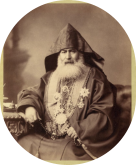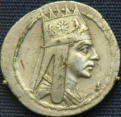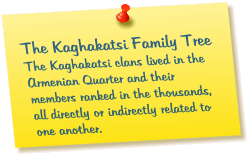

Armenian Jerusalem

Jerusalem, 2007



Two of the supreme leaders of the Armenian church in the Holy Land were kaghakatsis, members of the Mnatzaganian clan, according to family sources. This, despite the fact that an unwritten Patriarchate edict prohibits kaghakatsi youth from joining the church as members of the priestly Brotherhood of St James. Ardavazt Minassian, whose mother is a Mnatzaganian, and Apraham Mnatzaganian report separately that their common ancestral family included a son who later became Patriarch Giragos.
New Patriarch for Jerusalem

Patriarch Vehabedian
The
Armenian
church
in
Jerusalem
is
perched
on
the
verge
of
a
new
era
following
the
election
today
of
its
new
Patriarch,
the
97th
in
a
direct
line
of
succession
from
Abraham,
the
first
Armenian
patriarch of the Holy City.
Abraham
was
a
contemporary
of
the
Arab
Caliph,
Omar
ibnul
Khattab,
who
conquered
Jerusalem,
and
held
office
from 638 to 669 CE.
It
is
early
in
the
day
in
the
Old
City
of
Jerusalem,
and
virtually
no
one
is
up
and
around.
It
will
be
some
time
before
the
serenity
of
its
streets
and
alleys
is
disturbed
by
the
tread
of
heavy
feet
and
the
babble
of
many voices.
After
an
abbreviated
breakfast
of
"ka'ek"
(the
elliptical
bread
roll
cocooned
in
sesame
seeds)
and
"falafel,"
I
stand
before
the
ornately
decorated
gate
of
Deir
El
Siryan, the Syriac or Assyrian Convent of St Mark.
The
Armenians
of
Jerusalem
had
more
than
their
share
of
comedians,
clowns
and
pranksters:
they
thrived
on
laughter.
One
of
the
most
incorrigible
and
accomplished
was
Hortanan
(Jordan)
Marashlian,
a
Kaghakatsi.
He
was
ready
to
perform
at
the
drop
of
a
hat
-
if
anyone
deserved
an
Oscar,
it
would
be
him.
There
was
the
time
Hortanan
Marashlian
decided
to
spring
a
practical
joke on Im Arakel (Anna Baghsarian).
The Greek doctor
Sometime
during
a
lull
in
the
1948
Arab-Jewish
war,
a
group
or
urchins
were
trawling
through
the
ruins
of
a
china
shop
in
the
Armenian
Quarter.
They
found
nothing
worth
picking
in
the
shop
which
had
been
looted
and
thoroughly
thrashed.
Suddenly,
one
of
the
boys
shouted,
"I
found something."
It
was
a
heavy
metal
ball,
with
spikes
all
over
it,
a
veritable
treasure.
Still,
they
were
lucky:
the
unexploded
Mills
grenade
was
a
dud,
the
young
man
who
relieved
them
of
their
treasure
revealed,
as he disarmed it.
Some
of
those
boys
happened
to
star
in
another
dud
drama:
a
projectile
fired
by
either
the
Arabs
or
the
Jews
landed
in
the
kitchen
of
a
family,
but
failed
to
explode.
It
was
only
the
bravery
of
a
man,
who
was
dwarfed
by
the
missile's
size,
who
carried
it
bodily
down
the
stairs.


No pineapple!
Kaghakatsi patriarchs: Giragos, Harutiun
First Syriac priest ordained in century





The 1920’s: a watershed for Armenian Jerusalem
The
late
1920s
were
a
watershed
in
the
history
of
the
Armenians
in
the
Holy
Land.
It
was
during
this
seminal
epoch
that
the
Armenian
community
laid
the
groundwork
for
a
school
of
its
own,
the
Tarkmanchatz,
which
has
given
the
world
more
than
its
quota
of
luminaries
(including
Ohan
Durian,
the
great
composer)
as
well
as
a
large
library,
both
institutions
gifts
of
Calouste
Gulbenkian,
who
was
known
in
oil
and
financial
circles
as
Mr
Five
Percent,
a
reference
to
his stake in the Iraq Petroleum Company.
The
library
ranks
as
one
of
the
most
important
in
the
Armenian
diaspora.
It
boasts
close
to
100,000
volumes,
of
which
less
than
half
are
in
Armenian.
The
rest
are
mainly
in
English,
French,
and
German,
as
well
as
quite
a
few
dead
languages, including hieroglyphics.

The gentle conscript
Like
many
young
Kaghakatzi
men
of
his
age,
Hagop
Hovsepian
(who
later
changed
his
family
name
to
Hagopian),
was
conscripted
into
the
Ottoman
army
during their occupation of Palestine.
But
unlike
several
of
his
compatriots
who
perished
during
Sefer
Berlik
(First
World
War),
he
survived.
He
did
return
home, but he was a broken man.


News Headlines
Armenian arts and crafts
Jerusalem Armenians have had their
share of poets, troubadours and story-
tellers, but although records or anthologies
of the accomplishments of previous
generations are non-existent, memories still
linger among their descendants, some of these
very vivid.
The Gulbenkians in Jerusalem
For most of the world, Calouste
Gulbenkian will always be known as Mr
Five Percent, the man who held that
much stock in the Iraqi Petroleum
Company. But for Armenians in general,
and their Old City of Jerusalem in
particular, the name Gulbenkian evokes
notions of a much grander and more
lasting perspective.
The Armenian Church
The church has always dominated the Armenian
Jerusalem landscape. Throughout its
troubled history, it has always been the priestly
brotherhood that has provided the
Armenians with the impetus and inspiration to
forge ahead. Priests invented the Armenian
alphabet, they were in the vanguard of armies on
the march, they gave Jerusalem its first
printing press and its first photographic studio,
they copied and illustrated manuscripts,
their convent sheltered the battle- scarred flock
in the Old City of Jerusalem.
Some Armenian expressions
A
large
proporion
of
sayings
or
expressions
popular
among
the
Kaghakatsi
Armenians,
are
derived
from
either
Turkish
or
Arabic.
Here is a sampling:
Sako
(coat)
Bisseh
(cat)
Falagha
(loudmouth)
Tarmah
(idiotic, female)
Atram
(idiot, male)
Kakikipcheh
(busybody)
Shalabi
(nice)
Bedkaran
(toilet)
‘Hanafiyeh
(faucet)
Kubbash
(wild hair)
Churchbayeh
(screen door)
Chakouj
(hammer)
Shartootah
(rag)
Chatal
(fork)
Kabboud
(heavy coat)
Tata
(henpecked)
Sobbah
(heater)























